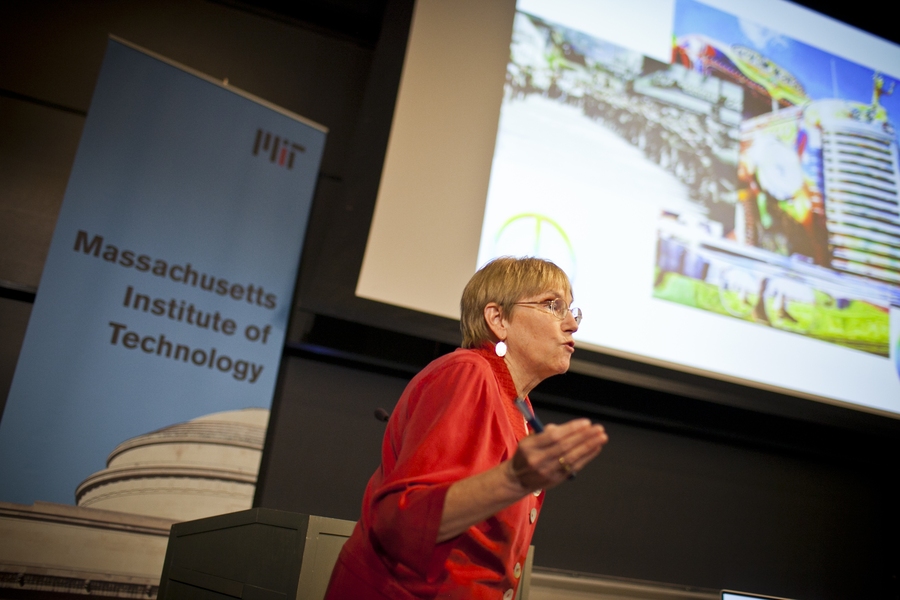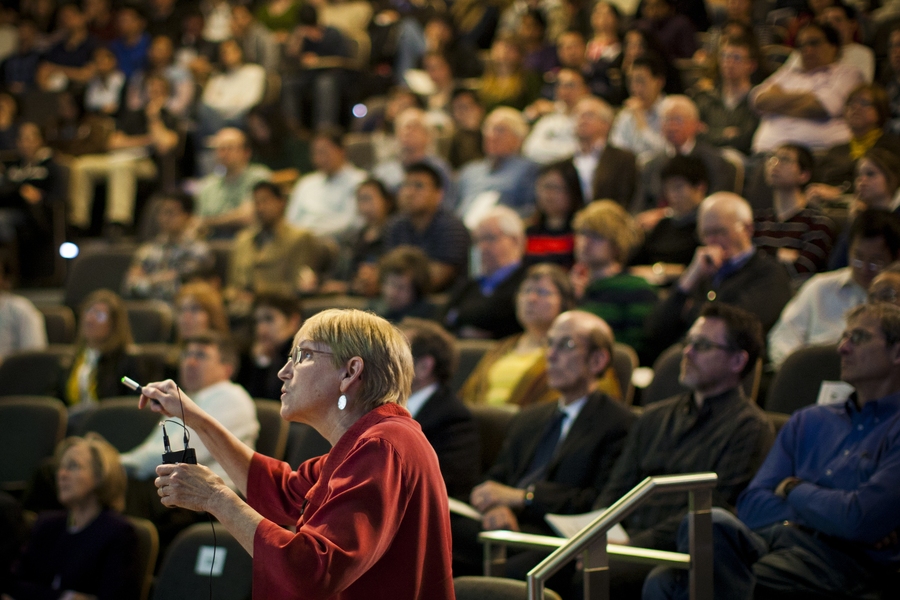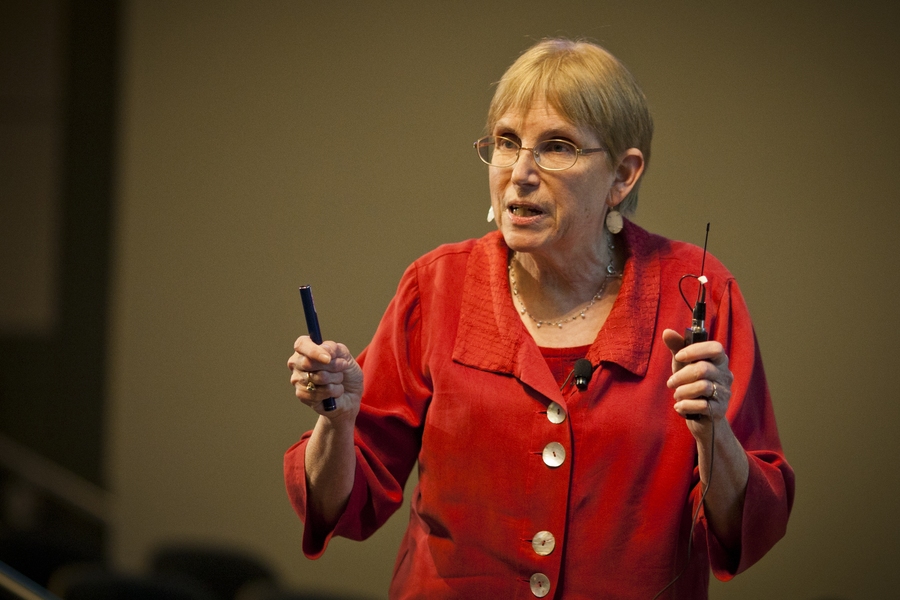For biochemist JoAnne Stubbe, “radical” is a word with many associations.
In the late 1960s, Stubbe was a graduate student at the University of California at Berkeley, where student demonstrators picketed against the Vietnam War. She recalls that at the time, radicals were seen as protestors who were “highly reactive, that one had difficulty controlling and that wreaked havoc on everything they interacted with.”
But from Stubbe’s perspective, the “radicals” were merely reacting to their immediate environment — namely, the lines of policemen sent to quell the protests, “guns raised, masks on.”
“Little did I think that these experiences back in those days would foreshadow the fact that I have spent 30 years of my life working on radicals in biology,” said Stubbe, who delivered MIT’s Killian Faculty Achievement Award Lecture on Tuesday.
Given their instability and the damage they can wreak, Stubbe says free radicals have commonly been “vilified.” However, just as with student protestors in the 1960s, Stubbe says the effect of free radicals is largely a consequence of their environment.
Stubbe’s research has focused on mapping the chemical environment in which “good radicals” form, concentrating on a group of enzymes called ribonucleotide reductases (RNR). These enzymes convert nucleotides — the precursors of RNA — into deoxynucleotides — the building blocks of DNA — and are essential to all organisms in replicating and repairing DNA.
Scientists have found that RNR converts nucleotides through a complex oxidation process spanning a physical distance of 35 angstroms; most chemical reactions take place within just a few angstroms.
“The question is, how do you do oxidation over this long a distance?” Stubbe said.
Using a variety of tools, Stubbe has traced RNR’s long chemical pathway, finding that in order for the enzymes to work, they require a chain of free-radical reactions. These radicals trade electrons down the chain — in a process Stubbe likens to “hopping” — until the original nucleotide is converted to a deoxynucleotide.
“Nature has figured out how to harness the reactivity of these radicals to do extremely difficult chemical transformations with exquisite specificity,” Stubbe said.
Now researchers are harnessing Stubbe’s discoveries to design therapies for cancer and other diseases that involve uncontrolled DNA replication. Stubbe is currently investigating the mechanisms behind drugs such as gemcitabine, a chemotherapeutic used to treat pancreatic cancer and other carcinomas. Gemcitabine acts to inhibit RNR activity, which in turn stops DNA replication and triggers tumor-cell death. Stubbe’s research group is also exploring ways to reduce the activity of free radicals involved in RNR — a potential mechanism for RNR inhibition.
“These are really reactive radicals that can be controlled,” Stubbe said. “Your life is in their hands.”
Stubbe is the recipient of the National Academy Prize in Chemistry, the National Medal of Science, the Franklin Institute Award in Chemistry and the Welch Award in Chemistry. In recognition of her research and teaching, last May the MIT faculty awarded Stubbe the Killian Faculty Achievement Award, established in 1971 as a tribute to James R. Killian, Jr., MIT’s 10th president.
Mary Fuller, a professor of literature and associate chair of the MIT faculty, presented Stubbe with the award and read from the award citation:
“When she began her work, it was believed that a radical mechanism was impossible because of the radical’s chemical reactivity. Now, due to Professor Stubbe’s work uncovering the intricate processes by which cells safely use free radicals, this is textbook material.”
In the late 1960s, Stubbe was a graduate student at the University of California at Berkeley, where student demonstrators picketed against the Vietnam War. She recalls that at the time, radicals were seen as protestors who were “highly reactive, that one had difficulty controlling and that wreaked havoc on everything they interacted with.”
But from Stubbe’s perspective, the “radicals” were merely reacting to their immediate environment — namely, the lines of policemen sent to quell the protests, “guns raised, masks on.”
“Little did I think that these experiences back in those days would foreshadow the fact that I have spent 30 years of my life working on radicals in biology,” said Stubbe, who delivered MIT’s Killian Faculty Achievement Award Lecture on Tuesday.
- Video: Watch the Killian Lecture
Given their instability and the damage they can wreak, Stubbe says free radicals have commonly been “vilified.” However, just as with student protestors in the 1960s, Stubbe says the effect of free radicals is largely a consequence of their environment.
Stubbe’s research has focused on mapping the chemical environment in which “good radicals” form, concentrating on a group of enzymes called ribonucleotide reductases (RNR). These enzymes convert nucleotides — the precursors of RNA — into deoxynucleotides — the building blocks of DNA — and are essential to all organisms in replicating and repairing DNA.
Scientists have found that RNR converts nucleotides through a complex oxidation process spanning a physical distance of 35 angstroms; most chemical reactions take place within just a few angstroms.
“The question is, how do you do oxidation over this long a distance?” Stubbe said.
Using a variety of tools, Stubbe has traced RNR’s long chemical pathway, finding that in order for the enzymes to work, they require a chain of free-radical reactions. These radicals trade electrons down the chain — in a process Stubbe likens to “hopping” — until the original nucleotide is converted to a deoxynucleotide.
“Nature has figured out how to harness the reactivity of these radicals to do extremely difficult chemical transformations with exquisite specificity,” Stubbe said.
Now researchers are harnessing Stubbe’s discoveries to design therapies for cancer and other diseases that involve uncontrolled DNA replication. Stubbe is currently investigating the mechanisms behind drugs such as gemcitabine, a chemotherapeutic used to treat pancreatic cancer and other carcinomas. Gemcitabine acts to inhibit RNR activity, which in turn stops DNA replication and triggers tumor-cell death. Stubbe’s research group is also exploring ways to reduce the activity of free radicals involved in RNR — a potential mechanism for RNR inhibition.
“These are really reactive radicals that can be controlled,” Stubbe said. “Your life is in their hands.”
Stubbe is the recipient of the National Academy Prize in Chemistry, the National Medal of Science, the Franklin Institute Award in Chemistry and the Welch Award in Chemistry. In recognition of her research and teaching, last May the MIT faculty awarded Stubbe the Killian Faculty Achievement Award, established in 1971 as a tribute to James R. Killian, Jr., MIT’s 10th president.
Mary Fuller, a professor of literature and associate chair of the MIT faculty, presented Stubbe with the award and read from the award citation:
“When she began her work, it was believed that a radical mechanism was impossible because of the radical’s chemical reactivity. Now, due to Professor Stubbe’s work uncovering the intricate processes by which cells safely use free radicals, this is textbook material.”









